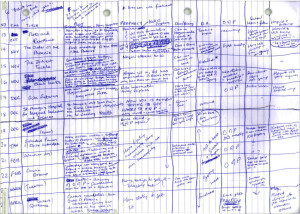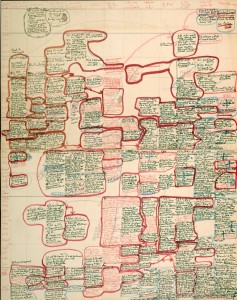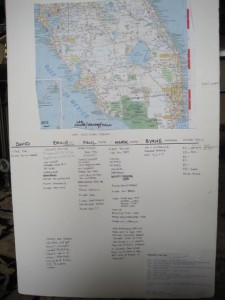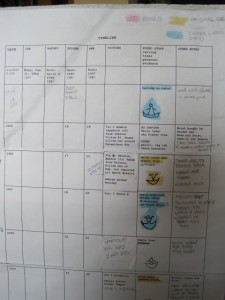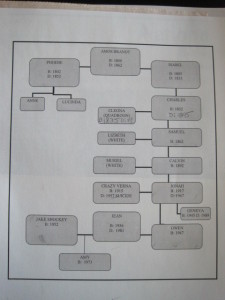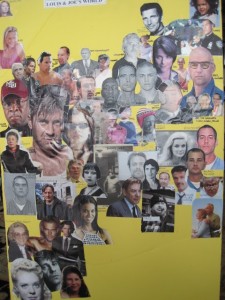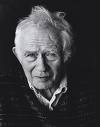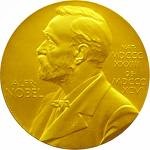Writing a novel can drive you crazy. There are all these characters running around yakking their heads off and doing weird things. Sometimes I feel like I have no control over any of it.
It makes me think I need one of those big ugly organizational flow charts you might see on the wall of oh, I dunno, the IRS?
Crazy, right? Well, if I’m nuts than so is J.K. Rowlings. And Norman Mailer. And Joseph Heller. And Henry Miller.
Because all of them, I found out this week, make drawings and charts and elaborate maps to help them find their ways through the thicket of plot and characters. Check this out:
This is J.K. Rowling’s spreadsheet plan for
Harry Potter and the Order of the Phoenix. (Click to make image larger…you’re gonna need it). And below is Norman Mailer’s drawing for
Harlot’s Ghost. (To see other famous writer examples
CLICK HERE.)
At first this made me think of that axiom about sausage-making and the law, that it’s better not to see them being made. Don’t we all — readers and writers alike — want to believe that novels arise from some deep mystic well of creativity? But then I realized that no, I really enjoy it when I get a glimpse of the architecture beneath a novel. And like I said, it also makes me feel less…nuts.
We talk alot here at The Kill Zone about the difference between plotters vs pantsers. (ie do you outline or do you wing it?). But we never talk about the picture makers. I am a picture maker. I can’t keep control of my story, can’t control its pacing and rhythms, can’t really SEE where it’s going, unless I draw it.
I used to think I was alone in this but I found out many authors use some kind of story boarding. Some even use software for it, Scrivner being a favorite. My dear late friend Barbara Parker had beautifully rendered storyboards on her office wall that would have made any Hollywood mogul proud. My scribbles aren’t nearly so neat but they do the job. It also something born of necessity because if you work with a collaborator, you both have to be literally on the same page.
My co-author sister Kelly and I happened upon our methodology by accident about nine books ago. She was visiting me here in Florida and one day I came home and saw this:
Kelly had written all our plot points down on scraps of paper and taped them to a board. (The wine is an optional but vital writing tool). We found this was a quick way to visualize our plot, move chapters or add things. It also acts as a chronology and time line, which is valuable during rewrites.We eventually graduated to Post-It notes. And the PLOT BOARD, as we call it, became more complicated as we refined our methods:
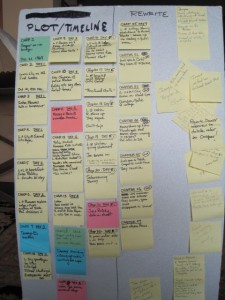
One Post-It per chapter, each with the salient plot points in that chapter. Usually, our Louis Kincaid books are written only from his POV so it’s all yellow. EXCEPT: we sometimes use pink for what we call “personal” chapters. This is because as we mix “case/plot” chapters with character-development chapters (ie personal) we are constantly aware of the need to keep the main plot moving. Too many pinks in a row? That’s death in a suspense novel so we find a way to distribute that extra pink stuff around. It’s all about pacing. This board above, however, is for
HEART OF ICE, which is a more complex plot. It has five POVS, so we use a different color for each. Again, it helps with pacing.
But we do more than just plotting on boards. We often need some pretty elaborate drawings, maps, and charts to keep track of things.
This board above was for
THE LITTLE DEATH. The plot concerns multiple bodies found in disparate locations in Florida’s cattle country. Louis finds no connections between the murders until he digs deep into each victim’s life. This board helped up keep the victims’s backgrounds straight as well as where the bodies were found in relation to each other (an important clue).
Here is a board for
A THOUSAND BONES. This book drove us nuts because the plot, about a serial killer operating over almost 20 years, was very complex. Its backstory begins in 1964 and the main plot moves to 1990. The killer left tree carvings with each victim but the carvings changed as he got older. We had to kept track of each girl’s backstory, where the body was found (the color coding), what personal items were found with each, and what carving.
We do a lot of family trees. This one above was for
SOUTH OF HELL. Almost none of these characters appear in the book but we had to know who begat who, mainly because Louis happens upon an old family Bible that helps him solve the case. In another book, ISLAND OF BONES, there is a weird multi-generational family living on a remote island in the Florida gulf and Louis discovers a cemetery where the headstones give him major clues. The family tree was so tangled our publisher even put a diagram in the book.
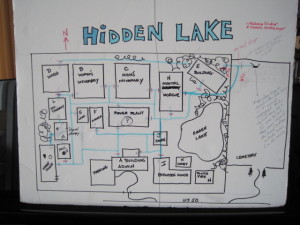
Above might explain why, despite the fact I was an art major, I do not make my living that way. Seriously, it is a drawing I did for our book AN UNQUIET GRAVE. It is set in an abandoned insane asylum and because I was having trouble explaining to Kelly how I pictured the grounds and buildings, I drew this for her. The blue connecting lines? Those are the tunnels in which our hero Louis gets lost and almost killed.
One of the biggest problems I think many manuscripts have is that the reader can’t VISUALIZE the physical action ie the moving around in physical space of the characters. Because the writer has not done an adequate job of describing places and actions, we are confused. And maybe it’s simply because the writer did not take the time to “draw” things out in his own mind. It’s important that a writer be able to clearly SEE a story so that the reader can as well.
Speaking of seeing stuff…
This is our character board. We started it about twelve years ago just for fun. One day, feeling burned out after a hard day writing, we started thumbing through magazines finding pictures of people we thought looked like our characters. On here you’ll find Louis’s foster father Phil (actor Michael Rennie), his old boss Chief Wainwright (coach Bill Parcells), his lover Joe Frye (a young Charlotte Rampling), his best friend Mel Landeta (fellow author Jon King) and Roland the serial killer (a random shot we found on the State of Florida Department of Corrections website of mug shots). We did this for fun but, again, when you have two brains creating characters, it helps it you can visualize a real face.
Postscript: A couple days after I wrote this, I met with my critique group. They were having problems with a scene I had written where a character gets thrown out of a car on I-75. My mates couldn’t VISUALIZE what I had described and I found myself saying “Yeah but this is what I meant!” In frustration, I drew them a picture of the road and the swale, the car’s position, a little stick man body, etc. They all looked at me, shaking their heads, and one said, “Well, that’s not what you wrote.”
Bingo. Once I drew it, I realized I had everything wrong, including what side of the highway they were on.
What about you guys? I know we’ve got pantsers and plotters out there. Any picture makers? Send me your examples and we’ll do a follow up. Send them to killzoneblog at gmail dot com. (Sorry, gotta spell it out to avoid spammers) Show me your pictures!

